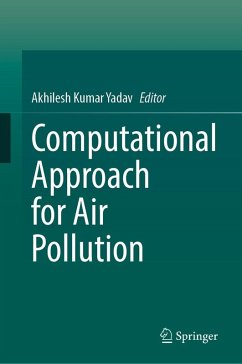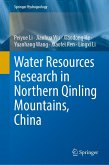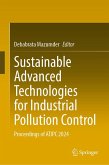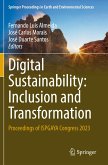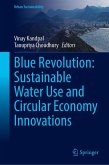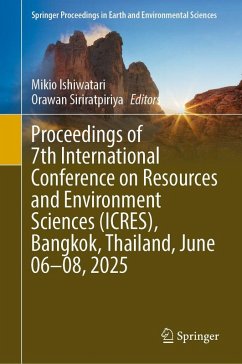Computational Approach for Air Pollution
Herausgegeben:Yadav, Akhilesh Kumar
Computational Approach for Air Pollution
Herausgegeben:Yadav, Akhilesh Kumar
- Gebundenes Buch
- Merkliste
- Auf die Merkliste
- Bewerten Bewerten
- Teilen
- Produkt teilen
- Produkterinnerung
- Produkterinnerung
Air pollution is a global environmental challenge that affects the health and well-being of millions of people worldwide. As the need for effective pollution control and mitigation measures continues to grow, so does the importance of advanced computational techniques in understanding, monitoring, and managing air quality. This contributed volume presents interdisciplinary cases that span the fields of environmental science, computer modeling, and data analysis to provide an overview of state-of-the-art computational methods used in tackling air pollution. This book offers an in-depth…mehr
Andere Kunden interessierten sich auch für
![Water Resources Research in Northern Qinling Mountains, China Water Resources Research in Northern Qinling Mountains, China]() Peiyue LiWater Resources Research in Northern Qinling Mountains, China121,99 €
Peiyue LiWater Resources Research in Northern Qinling Mountains, China121,99 €![Sustainable Advanced Technologies for Industrial Pollution Control Sustainable Advanced Technologies for Industrial Pollution Control]() Sustainable Advanced Technologies for Industrial Pollution Control174,99 €
Sustainable Advanced Technologies for Industrial Pollution Control174,99 €![Digital Sustainability: Inclusion and Transformation Digital Sustainability: Inclusion and Transformation]() Digital Sustainability: Inclusion and Transformation168,99 €
Digital Sustainability: Inclusion and Transformation168,99 €![Blue Revolution: Sustainable Water Use and Circular Economy Innovations Blue Revolution: Sustainable Water Use and Circular Economy Innovations]() Blue Revolution: Sustainable Water Use and Circular Economy Innovations121,99 €
Blue Revolution: Sustainable Water Use and Circular Economy Innovations121,99 €![Proceedings of 7th International Conference on Resources and Environment Sciences (ICRES), Bangkok, Thailand, June 06-08, 2025 Proceedings of 7th International Conference on Resources and Environment Sciences (ICRES), Bangkok, Thailand, June 06-08, 2025]() Proceedings of 7th International Conference on Resources and Environment Sciences (ICRES), Bangkok, Thailand, June 06-08, 2025174,99 €
Proceedings of 7th International Conference on Resources and Environment Sciences (ICRES), Bangkok, Thailand, June 06-08, 2025174,99 €![What's Around Design? What's Around Design?]() What's Around Design?151,99 €
What's Around Design?151,99 €![Integrating Design, Ecology, and Engineering for Sustainable Development Integrating Design, Ecology, and Engineering for Sustainable Development]() Integrating Design, Ecology, and Engineering for Sustainable Development174,99 €
Integrating Design, Ecology, and Engineering for Sustainable Development174,99 €-
-
-
Air pollution is a global environmental challenge that affects the health and well-being of millions of people worldwide. As the need for effective pollution control and mitigation measures continues to grow, so does the importance of advanced computational techniques in understanding, monitoring, and managing air quality. This contributed volume presents interdisciplinary cases that span the fields of environmental science, computer modeling, and data analysis to provide an overview of state-of-the-art computational methods used in tackling air pollution. This book offers an in-depth exploration of the tools, techniques, and strategies that have revolutionized our ability to study and address air quality issues.
Produktdetails
- Produktdetails
- Verlag: Springer, Berlin; Springer
- Artikelnr. des Verlages: 89546580
- Seitenzahl: 398
- Erscheinungstermin: 19. Januar 2026
- Englisch
- Abmessung: 235mm x 155mm
- ISBN-13: 9783032092144
- ISBN-10: 3032092140
- Artikelnr.: 75459244
- Herstellerkennzeichnung
- Springer-Verlag GmbH
- Tiergartenstr. 17
- 69121 Heidelberg
- ProductSafety@springernature.com
- Verlag: Springer, Berlin; Springer
- Artikelnr. des Verlages: 89546580
- Seitenzahl: 398
- Erscheinungstermin: 19. Januar 2026
- Englisch
- Abmessung: 235mm x 155mm
- ISBN-13: 9783032092144
- ISBN-10: 3032092140
- Artikelnr.: 75459244
- Herstellerkennzeichnung
- Springer-Verlag GmbH
- Tiergartenstr. 17
- 69121 Heidelberg
- ProductSafety@springernature.com
Akhilesh Kumar Yadav graduated Bachelor of Technology in Electronics and Communication Engineering from Chaudhary Charan Singh University in Meerut, India. He then obtained a Master of Technology in Environmental Engineering from Madan Mohan Malaviya Engineering College in Gorakhpur, India (affiliated with Dr. A. P. J. Abdul Kalam Technical University, Lucknow). His doctoral degree, with a research focus on air pollution, was awarded by the Indian Institute of Technology (Banaras Hindu University), Varanasi, India. Dr. Yadav has served at various institutions, including Indian Institute of Technology (Banaras Hindu University), Varanasi, India; Indian Institute of Technology Bombay, Mumbai, India; Bhabha Atomic Research Centre, Mumbai, India (as a research collab-orator); Manipal University Jaipur, Jaipur, India and Chaoyang University of Technology in Taichung, Taiwan. He has authored/co-authored several research and review articles, book chapters, and edited/authored books, and holds a patent. Dr. Yadav received the Young Engineer Award from the Institution of Engineers (India) and the Young Scientist Award from VDGOOD Technology Factory, Kolkata. His research interests include air, water, and soil pollution; climate change; vulnerability; human health risk assessments; and GIS applications in environmental pollution and management. He is an active member of several reputed international professional bodies, including the IEI (Kolkata), ECI (New Delhi), AEACI (Mumbai), MSI (New Delhi), and IASTA (Mumbai).
Chapter 1. Introduction to computational approaches in air pollution.-
Chapter 2. Understanding the health and environmental impacts of air
pollutants.- Chapter 3. Assessing the health and environmental consequences
of air pollution.- Chapter 4. Assessment on health and environmental
impacts due to air pollution.- Chapter 5. Air pollution and its impact on
health and environment in India.- Chapter 6. Analyzing air pollution
sources effect and mitigation strategies.- Chapter 7. Towards a data-driven
air pollution control strategy.- Chapter 8. Air pollution modeling using
computational approaches.- Chapter 9. Machine learning in air quality
prediction and control.- Chapter 10. Transforming air quality forecasting
with machine learning techniques.- Chapter 11. Machine learning for air
pollution prediction: A case study of Bhilwara, Rajasthan.- Chapter 12.
Emission inventories to AI-based prediction for air pollutants.- Chapter
13. Harnessing biodiversity for air pollution mitigation through
nature-based strategies and bioresource utilization.- Chapter 14. Digital
pathways to cleaner air: Reducing construction-related CO¿ through BIM,
digital twins, and artificial intelligence.- Chapter 15. Investigating the
relationship between urbanization and air pollution: New insights from
developed countries.- Chapter 16. Air pollution and recent trends in
control strategy.- Chapter 17. COVID-19 emission inventory and air quality
simulation in Madrin, Spain.- Chapter 18. Intuitionistic Fuzzy MCDM
Decision Making Technique for the Selection of Property.- Chapter 19.
Probabilistic and computational health risk modelling for assessment of air
pollution exposure.- Chapter 20. Advancing sustainable and inclusive
evaluation frameworks for health and environmental impact assessment.-
Chapter 21. Environmental and Public Health Concerns in a Sustainable
Future.
Chapter 2. Understanding the health and environmental impacts of air
pollutants.- Chapter 3. Assessing the health and environmental consequences
of air pollution.- Chapter 4. Assessment on health and environmental
impacts due to air pollution.- Chapter 5. Air pollution and its impact on
health and environment in India.- Chapter 6. Analyzing air pollution
sources effect and mitigation strategies.- Chapter 7. Towards a data-driven
air pollution control strategy.- Chapter 8. Air pollution modeling using
computational approaches.- Chapter 9. Machine learning in air quality
prediction and control.- Chapter 10. Transforming air quality forecasting
with machine learning techniques.- Chapter 11. Machine learning for air
pollution prediction: A case study of Bhilwara, Rajasthan.- Chapter 12.
Emission inventories to AI-based prediction for air pollutants.- Chapter
13. Harnessing biodiversity for air pollution mitigation through
nature-based strategies and bioresource utilization.- Chapter 14. Digital
pathways to cleaner air: Reducing construction-related CO¿ through BIM,
digital twins, and artificial intelligence.- Chapter 15. Investigating the
relationship between urbanization and air pollution: New insights from
developed countries.- Chapter 16. Air pollution and recent trends in
control strategy.- Chapter 17. COVID-19 emission inventory and air quality
simulation in Madrin, Spain.- Chapter 18. Intuitionistic Fuzzy MCDM
Decision Making Technique for the Selection of Property.- Chapter 19.
Probabilistic and computational health risk modelling for assessment of air
pollution exposure.- Chapter 20. Advancing sustainable and inclusive
evaluation frameworks for health and environmental impact assessment.-
Chapter 21. Environmental and Public Health Concerns in a Sustainable
Future.
Chapter 1. Introduction to computational approaches in air pollution.-
Chapter 2. Understanding the health and environmental impacts of air
pollutants.- Chapter 3. Assessing the health and environmental consequences
of air pollution.- Chapter 4. Assessment on health and environmental
impacts due to air pollution.- Chapter 5. Air pollution and its impact on
health and environment in India.- Chapter 6. Analyzing air pollution
sources effect and mitigation strategies.- Chapter 7. Towards a data-driven
air pollution control strategy.- Chapter 8. Air pollution modeling using
computational approaches.- Chapter 9. Machine learning in air quality
prediction and control.- Chapter 10. Transforming air quality forecasting
with machine learning techniques.- Chapter 11. Machine learning for air
pollution prediction: A case study of Bhilwara, Rajasthan.- Chapter 12.
Emission inventories to AI-based prediction for air pollutants.- Chapter
13. Harnessing biodiversity for air pollution mitigation through
nature-based strategies and bioresource utilization.- Chapter 14. Digital
pathways to cleaner air: Reducing construction-related CO¿ through BIM,
digital twins, and artificial intelligence.- Chapter 15. Investigating the
relationship between urbanization and air pollution: New insights from
developed countries.- Chapter 16. Air pollution and recent trends in
control strategy.- Chapter 17. COVID-19 emission inventory and air quality
simulation in Madrin, Spain.- Chapter 18. Intuitionistic Fuzzy MCDM
Decision Making Technique for the Selection of Property.- Chapter 19.
Probabilistic and computational health risk modelling for assessment of air
pollution exposure.- Chapter 20. Advancing sustainable and inclusive
evaluation frameworks for health and environmental impact assessment.-
Chapter 21. Environmental and Public Health Concerns in a Sustainable
Future.
Chapter 2. Understanding the health and environmental impacts of air
pollutants.- Chapter 3. Assessing the health and environmental consequences
of air pollution.- Chapter 4. Assessment on health and environmental
impacts due to air pollution.- Chapter 5. Air pollution and its impact on
health and environment in India.- Chapter 6. Analyzing air pollution
sources effect and mitigation strategies.- Chapter 7. Towards a data-driven
air pollution control strategy.- Chapter 8. Air pollution modeling using
computational approaches.- Chapter 9. Machine learning in air quality
prediction and control.- Chapter 10. Transforming air quality forecasting
with machine learning techniques.- Chapter 11. Machine learning for air
pollution prediction: A case study of Bhilwara, Rajasthan.- Chapter 12.
Emission inventories to AI-based prediction for air pollutants.- Chapter
13. Harnessing biodiversity for air pollution mitigation through
nature-based strategies and bioresource utilization.- Chapter 14. Digital
pathways to cleaner air: Reducing construction-related CO¿ through BIM,
digital twins, and artificial intelligence.- Chapter 15. Investigating the
relationship between urbanization and air pollution: New insights from
developed countries.- Chapter 16. Air pollution and recent trends in
control strategy.- Chapter 17. COVID-19 emission inventory and air quality
simulation in Madrin, Spain.- Chapter 18. Intuitionistic Fuzzy MCDM
Decision Making Technique for the Selection of Property.- Chapter 19.
Probabilistic and computational health risk modelling for assessment of air
pollution exposure.- Chapter 20. Advancing sustainable and inclusive
evaluation frameworks for health and environmental impact assessment.-
Chapter 21. Environmental and Public Health Concerns in a Sustainable
Future.

